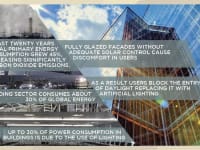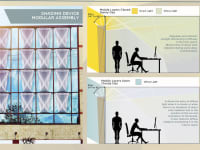Demand of fossil fuels used for energy generation is growing, resulting in emissions of carbon dioxide and other contaminant particles. In the last twenty years the global primary energy consumption grew 45% (BP 2011), increasing emissions of carbon dioxide between 1993 and 2011 by 44%. The excessive presence of these particles in the Earth's atmosphere intensifies the greenhouse effect, causing an increase in global temperature, which leads to global warming and climate change. Although the building sector consumes about 30% of global energy and generates a significant amount of carbon dioxide emissions (IPCC 2007), it is an area with great potential for energy savings (IEA 2011). The most efficient way to reduce energy consumption by artificial lighting is using daylight to illuminate indoor spaces, especially in regions with clear sky.
In contemporary society, architectural trend can be seen in buildings that are designed with large glass surfaces, regardless of their impact on energy consumption. Thus, the excessive and uncontrolled entry of direct solar radiation, makes users block the entry of sunlight replacing it with artificial lighting sources, missing out on the benefits daylight provides to biological and psychological human rhythms.
TRAMA is a modular complex-shading device that takes advantage of the availability of daylight in buildings with glazed facades. Its main feature is the integration in a single product of redirection and shading properties. In use, TRAMA diffuses direct solar radiation and reduces solar gain during sunny days, avoiding glare situations. Likewise, it allows the entry of diffuse light when it is cloudy or when there is no incidence of direct solar radiation due to the position of the sun and orientation of the facade. In this manner, it regulates and redirects sunlight distributing it diffusely in the inner space. This product is composed of three curved anodized aluminum profiles connected by TPU threads coated in PVC, which make the screen, fixed to the facade of the building by anchors. The upper screen consists of a tight woven, which is mirrored finish, emulating a reflective surface that redirects the sunlight to the ceiling, increasing the amount of daylight available and improving its distribution inside. The front screen is composed of overlapped threads distributed in vertical layers. An exterior photosensitive sensor allows computerized displacement of the inner layer fastening points, opening or closing of the woven, through a rail system.
In the current context of global energy crisis TRAMA is a product that can reduce lighting consumption in buildings creating a possible solution for the adequate use of daylight, and also preserves adequate space daylighting conditions and wellbeing of its occupants.
References
- BP p.l.c. (2011). BP Energy Outlook 2030. London, United Kingdom.
- Intergovernmental Panel on Climate Change. IPCC. Technical Guidelines for Assessing Climate Change Impacts and Adaptations, 2007.
- International Energy Agency. IEA. World Energy Outlook 2011, Paris.
Video
Like this entry?
-
About the Entrant
- Name:Victoria Santiago
- Type of entry:teamTeam members:Ana Acquaro
- Software used for this entry:AutoCAD 2016, 3DMax 2010, Adobe Illustrator CS6, Adobe Photoshop CS6
- Patent status:none








